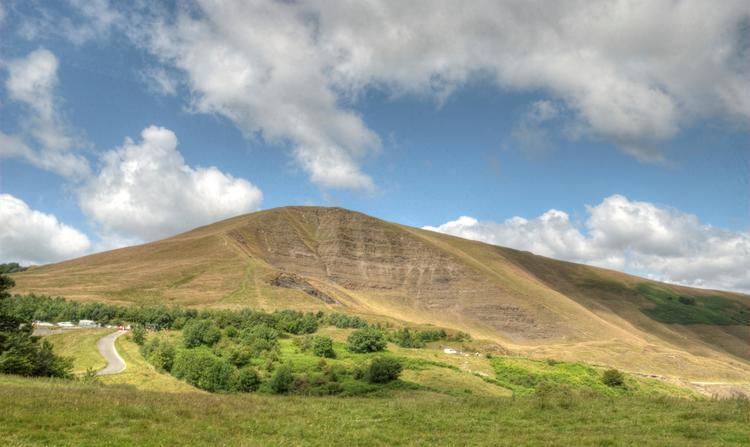Prominence 62 m (203 ft) OS grid SK127836 | Location Derbyshire, England Elevation 517 m Listing Dewey | |
 | ||
Topo map OS Explorer OL1OS Landranger 110 Similar Peak District, Lose Hill, Kinder Scout, Winnats Pass, Speedwell Cavern | ||
Peak district walk the great ridge mam tor lose hill walk
Mam Tor is a 517 m (1,696 ft) hill near Castleton in the High Peak of Derbyshire, England. Its name means "mother hill", so called because frequent landslips on its eastern face have resulted in a multitude of 'mini-hills' beneath it. These landslips, which are caused by unstable lower layers of shale, also give the hill its alternative name of Shivering Mountain. In 1979 the continual battle to maintain the A625 road (Sheffield to Chapel en le Frith) on the crumbling eastern side of the hill was lost when the road officially closed as a through-route.
Contents
- Peak district walk the great ridge mam tor lose hill walk
- Map of Mam Tor Hope Valley UK
- Peak district country walk castleton to lose hill and mam tor round
- GeographyEdit
- Mam Tor landslideEdit
- PrehistoryEdit
- References
Map of Mam Tor, Hope Valley, UK
At the base of the Tor and nearby are four show caves: Blue John Cavern, Speedwell Cavern, Peak Cavern and Treak Cliff Cavern where lead, Blue John, fluorspar and other minerals were once mined.
Peak district country walk castleton to lose hill and mam tor round
GeographyEdit
Mam Tor is on the southern edge of the Dark Peak (sandstones) and overlooks the White Peak (limestones), including the notable dry gorge of Winnats Pass. It is a dominating link between the eastern end of Rushup Edge and the western end of the Great Ridge, which together separate the Hope Valley to the south from Edale to the north, and is a popular ridgewalk.
Mam Tor is made of rocks of Carboniferous age, approximately 320 million years old. The base of Mam Tor is composed of black shales of the Bowland Shale Formation of Serpukhovian age overlain by turbiditic sandstone of the Mam Tor Sandstone Formation of Bashkirian age.
In perfect weather conditions, Manchester city centre, Stockport, and Winter Hill can be seen from here.
Mam Tor landslideEdit
The most notable feature of Mam Tor is the active landslip which invades its southeast side almost to the summit, and interrupts the ramparts of the hillfort, unless its builders used it as part of the defences. This rotational landslide began roughly 4,000 years ago. The toe is a debris flow. The landslide is due to weak shales underlying sandstones, a common phenomenon all around the Dark Peak, notably at Alport Castles, Longdendale, Glossop, and Canyards Hills, Sheffield. Indeed, three larger landslips occur on the north side of Mam Tor, one of them cutting the main ridge at Mam Nick which allows a minor road over into Edale; another creates the striking crag of Back Tor well seen from Mam Tor.
Evidence for the continued movement of the slide mass is demonstrated graphically by the severe damage to the old Mam Tor road that traversed this flow. The road was built at the beginning of the 1800s and was subsequently relaid until local authorities closed it in 1979. Layers of tarmac and gravel are up to 2 metres (6 ft 7 in) thick in places, demonstrating the numerous efforts to keep the road open. A short tunnel could readily have been made avoiding the landslip zone, but the opportunity to exclude heavy business and lorry traffic from the middle of the National Park was preferred. A local diversion for light vehicles follows the limestone gorge of Winnats Pass. Sheffield-Manchester traffic must now make a slow and lengthy detour over the A628 Woodhead Pass. This is one of the most extreme cases of geological problems affecting main transport systems in Britain, comparable with the railway at Dawlish.
Current mean annual movement is "up to 0.25 m; this increases greatly when winter rainfalls exceed thresholds of both 210 mm/month and 750 mm in the preceding six months."
The debris flow poses no threat to any inhabited buildings; however, small farm buildings lying in the flow's path may soon be overwhelmed assuming a flow rate similar to that of the present. The 2000 study suggests that deep drainage may be the most effective means of stabilising the flow, though this may not completely stop movement.
PrehistoryEdit
The summit of Mam Tor is encircled by a late Bronze Age and early Iron Age univallate hill fort. Radiocarbon analysis suggests occupation from around 1200 BC. The earliest remaining features are two Bronze Age burial mounds, one just below the summit and the other on the summit itself, though now buried under the paving. At a later stage over a hundred small platforms were levelled into the hill near the summit, allowing inhabited timber huts to be constructed. The hill fort and burial mounds are a Scheduled Ancient Monument.
